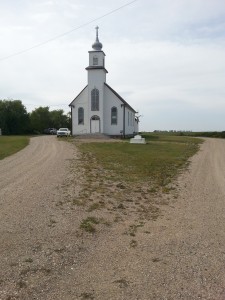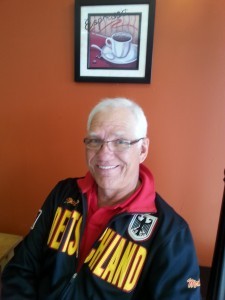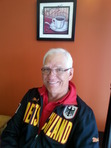A Trip In Time

St. Peter’s Church
St. Peter’s Colony
Saskatchewan Canada
As a writer, I utilize my personal experiences to construct the worlds I create. That and a vivid imagination. I have spent most of my life living in the shadow of the Rocky Mountains, splitting the time between urban city living and as much time as I could in the foothills and high mountain parks. Even though I moved to a more prairie like setting, the mountains were still within view and only an hour and a half away instead of an hour. Much of my working life was spent in the flat lands and prairies to the east of me, but I never really felt any connection to it. In the woods, I can find my way, spot landmarks to remember, even in the deepest bush. While the flat lands are wide open and I can see forever, it is an unfamiliar environment for me. How do you find water where their is none, shelter where it is non existent. Yet my ancestors and many more did just that. They not only survived, but thrived and prospered.
The content editor of Eagles Claw, Kate O’Donnel, asked me to describe the sites, sounds and smells of the prairie. A couple of years ago all I would have had to do was walk out my back door and sit in the middle of my twenty acres for an afternoon and it would have come to me. Unfortunately, or fortunately, depending on your view point, I moved closer to the woods and this option was no longer available for me to exploit. The next option was to go back to where I was born, where all of my family before me was born and my original ancestors first settled. I have made this trip many, many times. It is an eight hour trip under optimal conditions. Eight hours of mind numbing nothingness. Yet people live out their lives there. This time I allowed myself to experience the trip. It helped that unlike other trips in the past, the land was green. It is normally brown and burnt this time of year. It was also cooler than normal. Normally it hovers around thirty or more in the day and not much cooler at night.
I met up with my Aunt Linda and her clan. She is about five years older than me and our kids about the same age. My uncle died about six years ago. We always had a close relationship and he was my dads youngest brother. I also spent some time with my Godmother, my dads oldest sister. She answered a few of my questions, but really, like my dad, nobody really knew about the old days. It had never been important to them to know. I think a lot of it had to do with the First and Second World Wars. None of them wanted to know about their heritage. It is sad if you think about it. My mother’s grandfather had written down a brief account of his life in the colonies of Russia, but my father’s people, for what ever reason had not. They would recount episodes from their own lives, but before the 1930’s, it is mostly a blank.
So, off I went, to where one of my ancestors had established himself. He had arrived in Canada in 1891. The twenty year old, oldest son, his brothers and sisters, along with his parents, an uncle and his family and an unmarried aunt. By 1896, he was married, had four children and was one of the founding members of what is now called St. Peters Colony. It had originally been called Rastadt or Colony 7. They were Catholics, Germans and Russians.
I had been there about twenty years earlier and much has changed, but much is still the same. People are still living there. There are six houses on the north and six on the south of a broad street, almost double the size of a normal city street. Now the trees are large. There are new barns and outbuildings. Houses have been upgraded or replaced. The original church and and school are still there at the end of the street, as is the large outdoor shrine to Our Lady of Lourdes, located on the south west side of the colony, dug into the side of a twenty foot embankment cut by glacier runoff. A small stream still runs through the bottom. The land is fertile, but this year, the weather was hot and dry during the spring and the crops are poor. Looking around, it was a good spot to locate. There was a close source of open water, they could tunnel into the creek hillside to provide early housing and the prevailing winds were to the rear of the hillside. Their homes are on what looks to be twenty acre parcels, but their farms were located all around. This would have allowed them to keep vegetable gardens, milk cows, pigs and chickens close to home and go out to the farms and till the land or tend to cattle. The twelve families would have been able to support each other in times of need, or to help each other during harvest times or butchering times. Pooling resources, would have allowed easier transport of grain and excess herd animals to market. The long hard winters would have been much more bearable to endure. Many times they would have been cutoff from civilization due to high snow, wind and cold. I know from hearing personal anecdotes, that many families died during those times. Some from starvation or fires, some from the inability to endure the loneliness and the days and weeks of isolation and howling winds.
Even in the summer, the wind is ever present. You can see the farms, a couple of miles away, but in the winter after a January blizzard, there would be no way to contact or get to them. In this way, I think, my Great Grandfather was not only fortunate, but insightful. Even during the hard times of the 1930’s, we survived.
I have often wondered why I was always so comfortable with Ukrainian people. Why listening to my father in laws friends sing the old folk songs struck a cord deep in my soul. All of my people are German. Yet on this trip, I really saw the little church and the larger than life crucifixes at the corner of the quarter section the colony sits on and in front of the church with new eyes. They are not the Orthodox crucifixes with the double cross bars, nor the German with the roof over them, they are the Roman crosses. The church is a normal small town Catholic Church with a tall peaked steeple. Except. At the top of the steeple, is a Russian dome with a cross on top. In fact, the census’s I have found, they called themselves Russians, not Germans. The spoke German and English and Russian. At the time I met my wife and ultimately until just now, I did not understand what a Ukrainian Catholic was. Now I do.
I was married in a Ukrainian Catholic Church in a ceremony conducted in Ukrainian. Now I understand why my family was comfortable with all of it.
So on a trip to reconnect with the prairie, I actually discovered who I am. Like my ancestors said they were Russian, I am a Canadian. I just happen to have a German last name.
As an additional whack upside of the head. I had a wonderful diner with my cousin and now new Copy Editor, Cheryl Turley. I was privileged to be allowed to meet her roomy. Annia, a twenty eight year old, stunning blond Ukrainian, here on a work permit to teach gymnastics. I listened to her speak and observed her mannerisms and said to my self. Oh, my goodness! She is my Elizabeth, she is my Tanya! I wrote the Elizabeth character three years ago and the Tanya character last year! In my mind, I have the accents, the looks and the mannerisms perfect. I showed Cheryl the early manuscript of Bears Maul and Eagles Claw and she couldn’t believe it. Tanya, is Annia.
Go figure.




